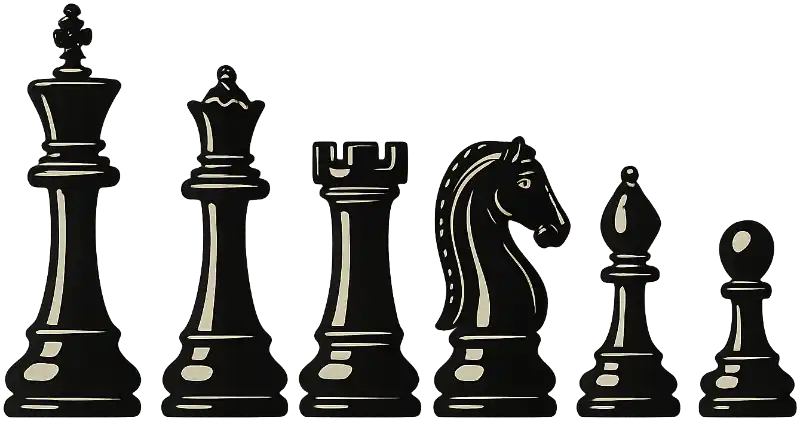Life is Tetris, Business is Chess
Entrepreneurs, tech professionals, and strategic thinkers frequently face uncertainty, complexity, and intense competition. They constantly seek analogies to clarify their understanding and sharpen their approach to challenges.
One compelling analogy is, “Life is like playing Tetris, while business resembles a strategic game of chess.” This analogy underscores the significance of adaptability in personal life and the crucial role of strategic foresight in business.

Life is Tetris
Tetris,1 a classic arcade game created by Alexey Pajitnov in 1984, embodies unpredictability and adaptability. Players manage falling geometric shapes, arranging them in real-time to prevent pieces from piling up and ending the game. Much like life, Tetris does not allow players to control what shapes come next. Success depends entirely on adapting effectively to ever-changing situations.
“In life, you can’t control the board.” — Observer
This perspective is vividly explored by Tim Urban2 and others, who suggest that approaching life like a chess game, with overly calculated and meticulously planned moves, can be counterproductive. Chess requires precise planning of several moves ahead, anticipating opponents’ responses, and avoiding unexpected complications. Life, however, rarely follows neat, predictable pathways.
In life, unforeseen challenges continually emerge, such as career shifts, personal setbacks, or market disruptions. Rigid adherence to a predetermined plan can leave one unable to pivot effectively. Adopting a Tetris mindset, characterized by nimbleness, adaptability, and responsiveness, enables individuals to thrive in uncertain situations. Accepting each new piece of life’s puzzle and finding the best immediate fit fosters resilience, flexibility, and continuous growth.
[Off-topic] Someone made a Tetris that you can play at your own time and leisure - Lazy Tetris.

Business is Chess
Conversely, business operates more like chess, where strategic foresight and calculated moves dominate. Chess3 fundamentally revolves around strategy, with players plotting multiple moves ahead, analyzing potential outcomes, and continually adjusting their tactics based on opponents’ actions.
“Tactics is knowing what to do when there is something to do. Strategy is knowing what to do when there is nothing to do.” — Savielly Tartakower
In business, this translates into meticulous market analysis, thorough competitor evaluation, and long-term strategic planning. Leaders require foresight, clarity of vision, and strategic depth to position their organizations advantageously. They must manage resources thoughtfully, anticipate industry trends, and navigate competitive threats.
Historical business giants, such as IBM, and contemporary leaders like Apple and Tesla illustrate this principle vividly. Their successes resulted from precise strategic decisions, much like those of chess masters who foresee the consequences of every move. These companies recognized that strategic positioning, resource allocation, and innovation demand deliberate and thoughtful long-term planning.
Tesla, for example, strategically decided to dominate the electric vehicle market through carefully executed steps: building infrastructure like Superchargers,4 designing compelling products such as Models S, 3, X, and Y, and securing essential resources like battery technology and raw materials. Each decision was methodically calculated, much like a chess player’s careful orchestration toward checkmate.

Chess Pieces
And here is my meek and fuzzy attempt to equate chess pieces to some of the key functions and heads of a company.
King. The CEO is an Analyst who reads and understands numbers, groks data, tracks cost and cash flow, and knows the numbers inside out. Know how to scale, predict the future, be a truth seeker, and be a fortune teller. Turn the business weaknesses into strengths. This is a symbol of leadership that must be protected, not overly mobile, but every decision affects the game.
Queen. The COO is the operator who glues everything together. Builds systems and operating processes. This is the wolf who remains calm at all costs, powerful, agile, and capable across the board. The COO is versatile and executes strategically. Often, the one who handles day-to-day operations and brings the CEO’s vision to life. This is an operational powerhouse, a strategic executor, and covers the most ground.
Knights. The Builder. Often led by the CTO, these are one or more of the people in Product, Engineering, or Design. They know the product better than the CEO/Founder, but they don’t want to get involved in running a company. They are always looking to build the best of whatever they are offering now. They challenge assumptions and push for excellence even when they are tempted to settle for enough. They stay hidden but are the ultimate building machines. They discuss details, not just concepts, think differently, solve problems creatively, and approach challenges from unique angles.
Rooks. They are sellers, such as the Chief of Sales. The CEO starts here but hands over the baton to this person. They sell certainties; they shape the entire environment of the sale. They are the people-person whose main job is to ensure financial health, oversee resources, and manage long-term financial strategies. They are reliable, foundational, linked with transparency, and forward planning.
Bishops. They are storytellers, such as the Chief of Marketing. The CEO can be the face of the story department, but the script is written by the Bishops.. They make the company unforgettable. They are strategic, far-seeing, brand storytellers, connecting internal and external audiences.
Pawns. The executives, VPs, and directors play critical roles in advancing the company. They can be promoted when they reach the other side, the milestones, and clip points. Operational leaders and key staff drive daily progress and can grow into leadership roles. They are the essential element with growth potential, and are the front-line force of the company.
Tetris + Chess
Interestingly, true mastery in life and business involves blending the adaptability of Tetris with the strategic rigor of Chess. Entrepreneurs and tech leaders must remain agile in responding to immediate challenges while maintaining strategic coherence and direction toward long-term goals.
The COVID-19 pandemic5 provided an excellent example of companies combining Tetris-like adaptability with chess-like strategic thinking. Businesses pivoted rapidly to remote work, reflecting Tetris-like flexibility, but did so strategically by aligning with long-term digital transformation objectives. This balanced approach allowed them not only to survive but also to thrive and reposition themselves for future success.
Try ’EM
- Foster Adaptive Leadership: Encourage flexibility and empower teams to make quick, informed decisions. Leaders who adapt swiftly to changing circumstances enhance organizational resilience.
- Maintain Strategic Clarity: Establish clear strategic goals and consistently communicate them throughout the organization to ensure alignment and effectiveness. Aligning daily adaptability with long-term objectives ensures steady progress toward achieving your objectives.
- Invest in Scenario Planning: Regularly engage in scenario planning to anticipate various market conditions, competitor moves, and internal challenges. This maintains strategic preparedness, similar to chess players studying future moves.
- Cultivate Continuous Learning: Foster a culture of continuous learning and improvement. Embrace failures as learning opportunities to enhance both adaptability and strategic thinking simultaneously.
“Life is Tetris, Business is Chess” offers entrepreneurs and strategic thinkers a practical and insightful framework for navigating life and business. It highlights the necessity of adaptability in handling life’s unpredictable challenges and emphasizes the importance of strategic foresight in achieving long-term business success.
Yet, beyond metaphors, actual achievement comes from acknowledging our human capacity for growth, adaptation, and strategic wisdom. By embracing both flexibility and thoughtful planning, we navigate uncertainty more effectively, creating paths not just for survival but for meaningful and lasting success.
Further Reading
- Your Life Is Tetris. Stop Playing It Like Chess.
- Life’s Tetris, Not Chess: Embracing the Unpredictable
- Beyond Chess: Why Life is More Like a Game of Tetris
- Your life is Tetris—stop playing it like chess
- Your Life Is Tetris. Stop Playing It Like Chess.
-
Tetris is a puzzle video game created in 1985 by Alexey Pajitnov, a Soviet software engineer. In Tetris, falling tetromino shapes must be neatly sorted into a pile; once a horizontal line of the game board is filled in, it disappears, granting points and preventing the pile from overflowing. ↩
-
Tim Urban is an author and blogger popular for his website, Wait But Why, of which Urban is the writer and illustrator. ↩
-
Chess is a board game for two players. It is an abstract strategy game that involves no hidden information and no elements of chance. It is played on a square board consisting of 64 squares arranged in an 8×8 grid. The players, referred to as “White” and “Black”, each control sixteen pieces: one king, one queen, two rooks, two bishops, two knights, and eight pawns, with each type of piece having a different pattern of movement. An enemy piece may be captured (removed from the board) by moving one‘s own piece onto the square it occupies. The object of the game is to “checkmate” (threaten with inescapable capture) the enemy king. ↩
-
The Tesla Supercharger network is an electric vehicle fast charging network built and operated by vehicle manufacturer Tesla, Inc. The Supercharger network was introduced on September 24, 2012, as the Tesla Model S entered production, with five sites in California, USA. ↩
-
The COVID-19 pandemic (also known as the Coronavirus Pandemic and COVID Pandemic), caused by severe acute respiratory syndrome coronavirus 2 (SARS-CoV-2), began with an outbreak of COVID-19 in Wuhan, China, in December 2019. Soon after, it spread to other areas of Asia, and then worldwide in early 2020. The World Health Organization (WHO) declared the outbreak a public health emergency of international concern (PHEIC) on 30 January 2020, and assessed the outbreak as having become a pandemic on March 11, 2020. ↩